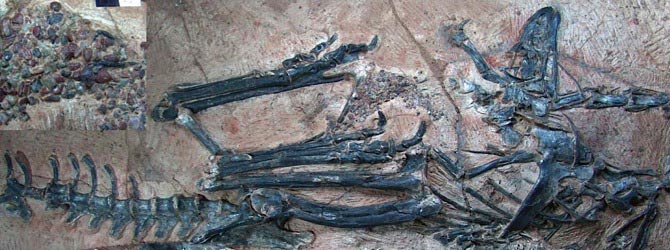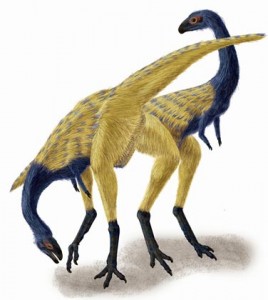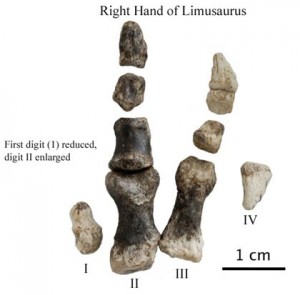Chinese Jurassic Ceratosaur Provides Evidence of Ancestral Link between Theropods and Birds
A recently discover Jurassic ceratosaur provides further evidence of an ancestral link between theropod dinosaurs and Aves.
The link between certain types of dinosaur and birds is largely accepted by many scientists today, the first rumblings about a connection can be traced back to the 1880s the time of Harry Govier Seeley, largely responsible for the taxonomic classification of Dinosauria. Indeed, the likes of the Thomas Henry Huxley in the early 1860s had remarked how similar anatomically dinosaurs were to birds; fuelled no doubt by the discovery of an almost complete skeleton of Archaeopteryx in 1861.
However, the paucity of the fossil record and the lack of key, transitional fossils showing animals evolving from one type of creature to another, the stages of evolution as it were, does mean that debate still continues as to the precise relationship between Dinosauria and Aves.
The Dinosauria/Bird Link
A recent study by scientists at the Oregon State University, analysing the process of bird’s breathing and their lung structure led this particular team of researchers to conclude that birds are not the direct descendants of theropod dinosaurs. Evidence gathered from their particular study indicated a shared, common ancestor but no direct descent.
To read more about the Oregon State University research: Controversy over the Dinosaurs/Birds Link.
This is one of the fascinating aspects of palaeontology, as new fossils are found, or as new techniques are developed to study known fossils, theories and concepts regarding Dinosauria change and evolve.
When trying to demonstrate some of the anatomical links between birds and dinosaurs a roast chicken or turkey can be dissected and some of the similarities shown. This is not recommended at Christmas, as it can interrupt the festivities and upset the cook. However, a couple of years ago, we did publish an article pointing out some of the things to look for when you carve the Christmas dinner.
To read this article: Christmas Dinner Links Dinosaurs to Birds.
One of the problems associated with the link between dinosaurs and birds was trying to explain the differences in the finger pattern seen in theropod dinosaurs and in birds. Put simply, the theropod ancestors of birds and birds share a characteristic of having three fingers (digits), problem is; theropods have digits I, II and III, whilst birds have digits II, III and IV. Now the discovery of a new, bizarre theropod with four fingers on each hand may provide evidence that explains this anomaly and help to unravel the mystery of how birds are descended from dinosaurs.
An international team of palaeontologists led by scientists from the Institute of Vertebrate Palaeontology and Palaeoanthropology (IVPP) in Beijing, have uncovered the articulated remains of a bizarre, beaked, herbivorous theropod that may shed some light on the bird/dinosaur digit mystery. In total two skeletons were found, including evidence of gastroliths (stomach stones) it is these stones that provide evidence of a tough, fibrous diet for this little, biped.
Jurassic Ceratosaur
The remains were found in Jurassic strata (Oxfordian faunal stage), dating this dinosaur to the Middle to Late Jurassic approximately 156 million years ago. The dinosaur has been named Limusaurus (means mud lizard), the binomial name is Limusaurus inextricabilis.
The Fossils of Limusaurus (L. inextricabilis)

Picture credit: James Clark
A Strange Theropod Dinosaur
The head of Limusaurus is towards the right of the picture, the beautiful and very well preserved caudal vertebrae (tail bones) of this dinosaur can be seen in the bottom left. In the centre of the picture between the claws of the hind legs a pile of gastroliths are shown, in what would have been the stomach cavity. This section of the fossil is enlarged and the individual stones can be made out (top left corner).
A total of two skeletons of this dinosaur have been found, identified as a member of the Theropoda, but a plant-eater, Limusaurus exhibits characteristics that may identify it as a transitional fossil, providing evidence on how dinosaur digits evolved and changed over time. The remains are of juveniles (analysis of bone fusion), these animals were 1.7 metres long, and lightly built, but it is not known how big a fully grown adult would have been.
The long hind limbs indicate that this dinosaur was a fast runner and as many other theropods from China have been discovered with primitive feathers, Limusaurus is illustrated as a feathered dinosaur. This dinosaur could not fly, but an active, cursorial lifestyle may indicate that this dinosaur was warm-blooded and the feathers would have helped insulate the animal and retain body heat.
An Artist’s Illustration of Limusaurus
Picture credit: Portia Sloan
An Unusual Theropod Dinosaur
Limusaurus is certainly an unusual theropod. Classified as a primitive Asian ceratosaur, this long-limbed, short-armed, toothless but beaked dinosaur may prove to be a transitional fossil helping to explain the evolution of Theropoda digits to the II, III, IV digit formation of birds. The remains were found in the Junggar Basin in the Xinjiang Uygur region of northwest China.
Xu Xing, one of the principal investigators and an illustrious member of the scientists at the IVPP describes this dinosaur as having four digits (fingers) on each of its small hands. Digits I, II, III and IV equivalent to the thumb, index finger, middle and the ring fingers in humans. However, digit I (thumb) is greatly reduced and the second finger (digit II – index) is very much larger, perhaps compensating for the vestigial state of the first digit.
Dinosaur Bird/Theory
Palaeontologists who supported the dinosaur-bird theory long faced a problem on fingers. Previous fossils of theropod dinosaurs showed earlier dinosaurs had five fingers and later ones gradually lost their ring finger and little finger, what is know as lateral shedding, the outside fingers went. Birds show skeletal traces of former fingers, the index, middle and ring fingers, in other words digits II, III and IV. The different digit formations is one of the major stumbling blocks when it comes to accepting the theory that birds are indeed descended from theropod dinosaurs and in essence highly evolved, avian dinosaurs. Limusaurus may provide evidence as to how the changes in fingers came about, Xu Xing commenting on the fingers of Limusaurus stated:
“The new Limusaurus indicated a different pattern of finger reduction. It was the thumb that was lost, instead of the ring finger”.
Co-author of the research paper on this new dinosaur, James Clark, of the George Washington University (United States) stated:
“This new animal is fascinating by itself, and when placed into an evolutionary context it offers intriguing evidence about how the hand of dinosaurs evolved into the hand of birds”.
The Right Hand (right manus of Limusaurus)
Picture credit: James Clark (annotation by Everything Dinosaur)
The international team re-examined hand skeletons of some previous fossils of theropods.
“We realised the pattern of their finger reduction was much more complicated than people had thought,” Xu added.
The scientists believe that the first digit becoming smaller and the importance of the second digit becoming greater indicate the beginnings of a trend in the evolution of dinosaur digits that would eventually lead to the configuration of II, III, IV as seen in birds. Limusaurus marks the beginning of a trend in finger development.
A New Hypothesis
They also presented a new hypothesis to explain why advanced theropods, from which birds were believed to have evolved, had the second, third and fourth fingers but they looked like the first three ones, as some fossils showed. Previously, palaeontologists believed that theropod dinosaurs as they evolved and changed over time, gradually lost fingers, but from the outside of the hand inwards (the lateral side).
Theropod dinosaurs have traditionally been assumed to have lost fingers from the lateral side inwards. This differs from the bilateral reduction seen in other tetrapod groups, i.e. losing digits from both the medial and lateral sides (inside and outside digits of the hand).
This strange reduction pattern is clearly present in primitive, basal theropods and has also been inferred in other types of theropod, based on the identification of their three-fingered hands (digits I, II and III present). However, this contrasts with the evidence from the extant theropods, the birds which have digits II, III and IV present.
Jurassic Ceratosaur
The evidence from the skeletal remains of Limusaurus indicate that the index finger may well be taking on the appearance and prominence of the thumb, a case of digit II evolving into digit I.
Xu Xing went on to state: “Homeotic changes might happen on dinosaurs, which means that the index finger has the features of a thumb. Such changes happened in humans, for example, a person usually has seven cervical vertebraes [neck bones] but, for some people, the first thoracic vertebrae has the feature of the cervical ones”.
Commenting on these findings, Alan Feduccia, (Palaeobiologist at the University of North Carolina) stated:
“If confirmed, this would be the only early dinosaur with a hand composed of the middle three digits, which is the same pattern as that of modern birds, albeit dramatically different in overall hand morphology, as well as having a highly abbreviated forelimb”.
He went on to add:
“The new fossil answers many questions and raises still another set of unknowns”.
Guenter Wagner, a renowned Yale evolutionary biologist, responded to the paper (published in the scientific journal Nature):
“There is very strong developmental evidence that there was a homeotic change in digit identity in the evolution of the bird lineage. I find it intriguing that there is more similarity to the 2,3,4 digits proximal, and more similarity to 1, 2, 3 digit identities distally”.
Wagner, however, remained neutral on the question of whether the morphology of this animal is a derived feature that may not be informative of the stages the bird lineage went through. This new research does provide some very interesting and intriguing questions, whether or not Limusaurus is a true transitional fossil has yet to be determined, but it does provide an interesting insight into one potential path from cursorial three-fingered dinosaurs to the birds that can be seen today.
Reference: Xing Xu et al, “A Jurassic ceratosaur from China helps clarify avian digital homologies” Nature 459:940 doi:10.1038/nature08124








Vargas, AO, Wagner GP, and Gauthier, JA. Limusaurus and bird digit identity. hdl.handle.net/10101/npre.2009.3828.1
Here is our response to the Limusaurus paper. It was recently rejected by nature, not for any technical reason but because it was considered not to be of sufficient interest/importance.
We have uploaded it at the nature precedings citable archive, because we think it is important there is a quick and citable reply that unlike Xu’s proposal, is consistent with the view of the larger community of theropod paleontologists, namely, that tetanuran digits still are I, II, III. We are preparing a longer paper on this topic.